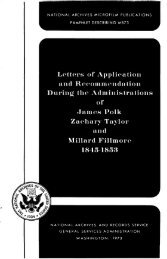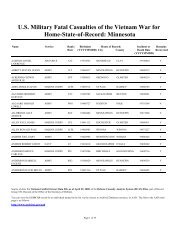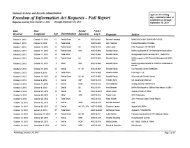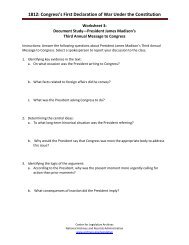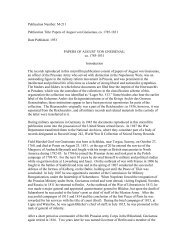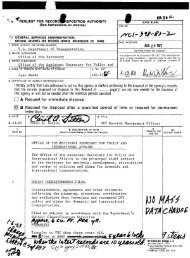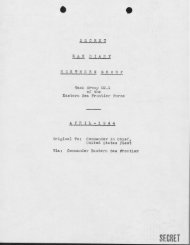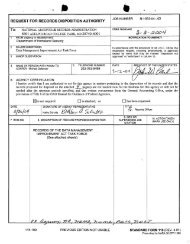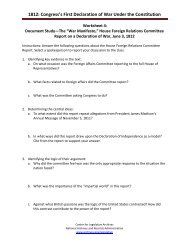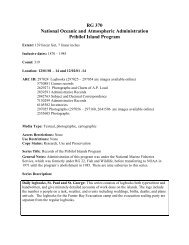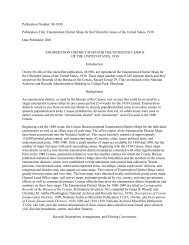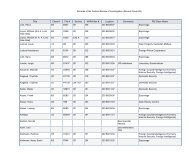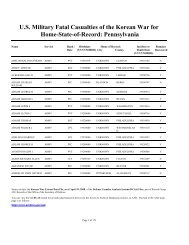HITLER'S SHADOW - National Archives and Records Administration
HITLER'S SHADOW - National Archives and Records Administration
HITLER'S SHADOW - National Archives and Records Administration
Create successful ePaper yourself
Turn your PDF publications into a flip-book with our unique Google optimized e-Paper software.
A CIC report from July 1947 cited sources that called Lebed a “well-known<br />
sadist <strong>and</strong> collaborator of the Germans.” 87 Regardless, the CIC in Rome took<br />
up Lebed’s offer whereby Lebed provided information on Ukrainian émigré<br />
groups, Soviet activities in the U.S. zone, <strong>and</strong> information on the Soviets <strong>and</strong><br />
Ukrainians more generally. In Munich, Hrinioch became a CIC informant as<br />
well. In November 1947 Hrinioch requested on behalf of B<strong>and</strong>era himself that<br />
the U.S. authorities move Lebed from Rome to Munich to protect him from<br />
Soviet extradition requests when American military government in Italy ended<br />
the following month. CIC in Munich was gaining Hrinioch’s confidence <strong>and</strong><br />
hoped to set up a meeting with B<strong>and</strong>era himself. 88 The Army moved Lebed <strong>and</strong><br />
his family to Munich in December. In the meantime, Lebed sanitized his wartime<br />
record <strong>and</strong> that of the B<strong>and</strong>era group <strong>and</strong> UPA with a 126-page book on the<br />
latter which emphasized their fight against the Germans <strong>and</strong> Soviets. 89<br />
The Berlin Blockade in 1948 <strong>and</strong> the threat of a European war prompted the<br />
CIA to scrutinize Soviet émigré groups <strong>and</strong> the degree to which they could provide<br />
crucial intelligence. In Project ICON, the CIA studied 30 groups <strong>and</strong> recommended<br />
operational cooperation with the Hrinioch-Lebed group as the organization<br />
best suited for cl<strong>and</strong>estine work. Compared with B<strong>and</strong>era, Hrinioch <strong>and</strong> Lebed<br />
represented a moderate, stable, <strong>and</strong> operationally secure group with the firmest<br />
connections to the Ukrainian underground in the USSR. A resistance/intelligence<br />
group behind Soviet lines would be useful if war broke out. The CIA provided<br />
money, supplies, training, facilities for radio broadcasts, <strong>and</strong> parachute drops of<br />
trained agents to augment slower courier routes through Czechoslovakia used by<br />
UPA fighters <strong>and</strong> messengers. 90 As Lebed put it later, “the … drop operations were<br />
the first real indication … that American Intelligence was willing to give active<br />
support to establishing lines of communication into the Ukraine.” 91<br />
CIA operations with these Ukrainians began in 1948 under the cryptonym<br />
CARTEL, soon changed to AERODYNAMIC. Hrinioch stayed in Munich, but<br />
Lebed relocated to New York <strong>and</strong> acquired permanent resident status, then<br />
U.S. citizenship. It kept him safe from assassination, allowed him to speak to<br />
Ukrainian émigré groups, <strong>and</strong> permitted him to return to the United States after<br />
operational trips to Europe. His identification in New York by other Ukrainians<br />
as a leader responsible for “wholesale murders of Ukrainians, Poles <strong>and</strong> Jewish<br />
(sic),” has been discussed elsewhere. 92<br />
86 | Collaborators



